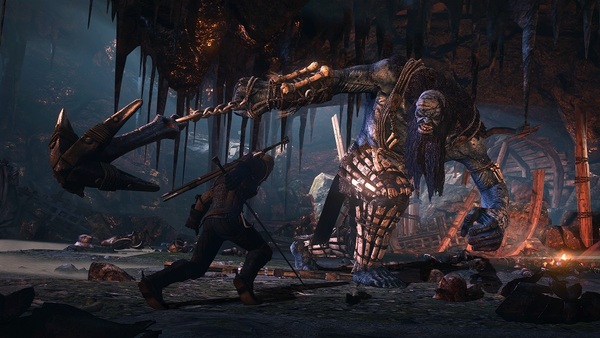Hands On With The Witcher 3: Wild Hunt—The Naked Truth
The lobby is dimly lit, the elevator is slow, and the already cramped space has been decorated with all kinds of gaming paraphernalia. I’m at a game preview event, and after a few minutes of awkwardly checking my phone and making small talk, the elevator finally arrives. I crowd in with a designer and several other journalists, and we slowly climb up to the fifth floor. More decorations have been set out there, but it’s hard to tell what is here for the event and what is here normally. Surely the gigantic Buddha head has nothing to do with the game, right? What about the carousel tiger? I say hello to the one other person I know here (another journalist) and take my seat with the maybe thirty other people. After a few minutes, the presentation begins, and we’re shown the intro cinematic for the game we are about to play.
The game in question is The Witcher 3: Wild Hunt, and the place we have gathered is The Alchemist, a bar in San Francisco’s South of Market (SoMa to regulars) district. The bar has an unusual setup. The building itself is small, but with several floors. The beginning of our presentation takes place on the fifth floor, and later, when we actually play the game, we will be on the second floor of the building, where it seems like the main portion of the bar is. The bar is pretty hip. The fifth floor has a standing bar, an exposed brick wall, nice white leather furniture.
As the presentation begins, Damien Monnier, senior gameplay designer for the game, takes the stage. He tells us a little about the game and what we should expect for our preview. Three hours of the game split into two different sections. He also spoke a little bit about Ciri, a female character that people will actually be able to play as during the game. Ciri is “an important part of the game,” Damien says. “So important that we wanted players to experience the game from her point of view.” I was a little saddened, however, because it seemed like we would not get to play as Ciri for very long; just one or two sections of the game. After his presentation, we get to play.
The Witcher series has had a somewhat problematic history with how it views women. The first game even gave you “trading cards” with depictions of naked women every time you have sex with someone, a puerile gesture in an otherwise darkly grim game. Perhaps naively, I had hopes that this game would have a more mature outlook. Those hopes were quashed, however, when the game opens in a classic Witcher tradition of offering up a naked woman for the (assumedly straight male) viewer in the first few minutes of the game. This scene would have made me uncomfortable if I was playing alone, so I was even more embarrassed by being surrounded by many other people, some playing the game and viewing the scene too, and others (several of whom are women) just working the bar. How did they feel about this, watching an audience of all men interact with a nude woman in this videogame? Furthermore, Geralt is also naked in this opening scene, but while the camera languishes over the woman, Geralt is never shown from the waist down. Now, Geralt is not exactly my type, but having some parity at the very least would have been nice.
